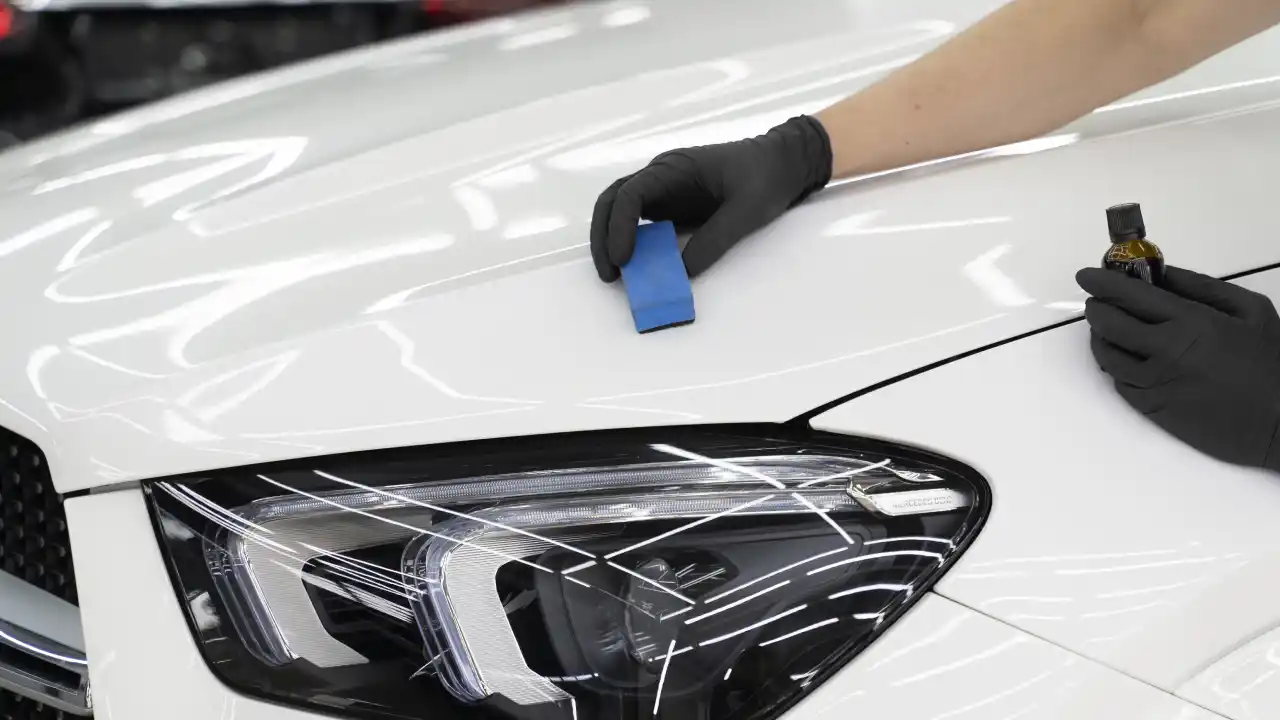Checking Out the Scientific Research Behind Ceramic Covering and Its Effect On Automobile Outlining
The application of ceramic layer in car outlining stands for a considerable development in automotive care, rooted in its sophisticated chemical buildings, primarily silica dioxide and titanium dioxide. As we check out the intricacies of the application procedure and the lasting ramifications for automobile maintenance, it ends up being clear that the choice of ceramic covering can fundamentally change one's method to cars and truck care.
What Is Ceramic Finish?
Ceramic finish is a modern solution that has actually obtained appeal in the automobile detailing market for its capability to provide long-lasting defense for automobile surfaces. This sophisticated safety layer is generally made up of silica dioxide (SiO2), which develops a strong bond with the automobile's paint, creating a durable guard against environmental contaminants. Unlike traditional wax or sealants, ceramic coverings provide superior resistance to UV rays, chemical discolorations, and physical abrasions.
The application of ceramic finish includes a careful process, where the vehicle's surface is thoroughly cleaned and decontaminated before the finishing is applied (Ceramic Coating). When treated, the layer enhances the lorry's gloss, depth, and clearness, giving a showroom-quality finish that lasts for years. Among the essential benefits of ceramic layer is its hydrophobic residential properties, which fend off water and dirt, making maintenance simpler and decreasing the regularity of laundries
The Chemistry of Ceramic Finishing
A basic aspect of ceramic finishing depends on its chemical make-up, mostly defined by the visibility of silica dioxide (SiO2) This substance is integral to the formation of a sturdy, protective layer that bonds chemically to the automobile's surface. When applied, the SiO2 particles undertake a process called polymerization, where they form a network of interconnected structures. This leads to a robust, hydrophobic surface that repels water and contaminants.
In addition to SiO2, numerous ceramic layers incorporate titanium dioxide (TiO2) and various other ingredients to enhance their performance qualities. TiO2, as an example, adds to raised hardness and chemical resistance. The interaction in between these substances produces a special molecular structure that supplies a high degree of protection versus environmental factors such as UV rays, acid rainfall, and oxidation.
Additionally, the application procedure commonly involves a thorough prep work of the surface to make sure ideal adhesion of the coating. This chemistry not just ensures a durable finish yet likewise enhances the visual appeal of the automobile. Understanding the detailed chemistry behind ceramic finishings is important for describing professionals that aim to supply superior security and longevity for their customers' automobiles.
Benefits of Ceramic Layer
While describing professionals frequently highlight the advantages of ceramic finishes, their advantages expand much past aesthetics. Ceramic coverings produce a hydrophobic surface that pushes back dirt, water, and gunk, significantly decreasing the frequency of laundries and the effort needed to keep a vehicle's look.
Moreover, ceramic finishes boost the durability of the lorry's coating. Unlike traditional waxes or sealers, which might last a couple of months, ceramic layers can endure for many years, providing a lasting remedy for auto treatment. This toughness equates to cost financial savings, as proprietors are less most likely to require frequent reapplication.
Additionally, ceramic layers are immune to chemical spots and etching, which can happen from acidic substances like bird droppings or tree sap. This resistance not only maintains the lorry's appearances but additionally decreases prospective damage - Ceramic Coating. On the whole, the financial investment in ceramic finish supplies auto proprietors a considerable return in terms of protection, convenience of maintenance, and durable aesthetic appeal, making it a progressively popular selection in the realm of automobile describing
Application Process Discussed

Once the surface is sufficiently prepared, the ceramic layer can be used. It is commonly carried out in a regulated setting, such as a garage or outlining bay, to stop contamination from dirt and particles. Utilizing an applicator pad, the specialist applies the coating in tiny areas, operating in a crosshatch pattern to ensure even insurance coverage. It is vital to follow the manufacturer's instructions regarding application thickness and healing times.
Once treated, the ceramic layer forms a strong bond with the paint, supplying boosted protection and a glossy surface. Correct application is important to make best use of the longevity and efficiency of the ceramic layer.

Long-term Influence on Lorry Treatment
The long-lasting impact of ceramic coating on see here vehicle treatment is considerable, as it essentially alters just how proprietors preserve their cars. By creating a sturdy, hydrophobic layer on the lorry's surface area, ceramic finishes reduce the adherence of dirt, grime, and impurities. This property lowers the frequency of cleaning called for, eventually saving water and cleaning items.
In Addition, the UV defense used by ceramic layers aids to protect against oxidation and fading of the automobile's paint, protecting its visual charm and resale value over time - Ceramic Coating. This safety obstacle likewise lowers the possibility of scrapes and swirl marks, which prevail problems in traditional paint surfaces
Moreover, ceramic finishings facilitate much easier maintenance, enabling proprietors to clean their automobiles with minimal initiative. The smooth surface area makes it challenging for impurities to bond, enabling easier elimination during regular cleaning.
In the future, the investment in ceramic layer may bring about cost financial savings in lorry care product or services. In general, the sustaining benefits of ceramic finishings not just enhance the appearance of automobiles but also add to an extra efficient and sustainable approach to car upkeep.
Verdict
In conclusion, the application of ceramic finish stands for a considerable innovation in automobile detailing, driven by its distinct chemical structure of silica dioxide and titanium dioxide. This innovation not only improves the visual charm of lorries yet also provides robust protection against environmental hazards and wear. The long-lasting benefits, including decreased maintenance frequency and enhanced longevity, highlight the worth of ceramic layers as an important investment for maintaining lorry look and integrity over time.
